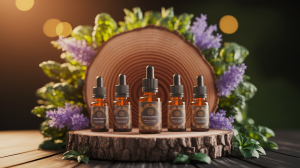Struggling with nail fungus but hesitant to try harsh chemical treatments? Tea tree oil might be the natural solution you’re looking for. This powerful essential oil has been used for centuries as a natural remedy for various infections, including stubborn nail fungus. You don’t need expensive prescription medications to start treating your infected nails! You can begin addressing your nail fungus at home with just a bottle of tea tree oil and a few common household items. Here’s how to use tea tree oil effectively and safely to combat nail fungus, with methods that work for both fingernails and toenails.
Effective Application Methods
Tea tree oil can be applied to fungal nail infections in several ways, each with its own advantages. Before starting any treatment, ensure your nails are clean, dry, and trimmed short to maximize effectiveness.
Cotton Ball Application
This method allows the antifungal properties of tea tree oil to penetrate the nail for an extended period:
- Mix 1-2 drops of tea tree oil with 1 teaspoon of a carrier oil like coconut or olive oil
- Soak a cotton ball in this mixture until saturated
- Press the cotton ball against the affected nail for 5 minutes
- Repeat this process twice daily, preferably morning and evening
The cotton ball technique is particularly effective for severe infections as it allows the oil to maintain contact with the infected area longer than quick applications.
Direct Cotton Swab Application
For more targeted treatment of nail fungus:
- Wash and thoroughly dry your feet or hands
- Dip a cotton swab into undiluted tea tree oil
- Apply 1-2 drops directly to the affected nail, ensuring you reach under the nail edge where fungi often hide
- Let the oil absorb completely before putting on socks or shoes
- Apply twice daily for best results
This direct application method works well for mild to moderate infections and allows you to target the affected areas precisely.
Nail Bath Technique
A soaking treatment that helps soften the nail while delivering the antifungal benefits:
- Fill a small basin with warm water
- Add 5-7 drops of tea tree oil and mix well
- Soak the affected nails for 15-20 minutes
- Dry thoroughly afterward
- Perform this soak once daily, preferably in the evening
This method is less concentrated but can complement other application techniques. It helps soften the nail, potentially improving the penetration of the tea tree oil.
Research and Efficacy Insights
Understanding how tea tree oil works against nail fungus can help you use it more effectively and set realistic expectations for your treatment.
Laboratory Studies Overview
Tea tree oil has shown promising results in laboratory settings. A 2013 study demonstrated that tea tree oil effectively inhibited the growth of Trichophyton rubrum, one of the most common fungi responsible for nail infections. The key component responsible for this antifungal activity is terpinen-4-ol, which directly attacks fungal cell membranes.
Research indicates that tea tree oil disrupts the fungal cell membrane’s integrity, leading to ion leakage and inhibition of cellular respiration, ultimately causing fungal cell death.
Human Trials and Their Implications
Human clinical trials have shown mixed but promising results:
A 1994 study found tea tree oil to be as effective as clotrimazole (a prescription antifungal) when applied directly to infected areas. However, a later 1999 trial showed limited improvement with tea tree oil alone, suggesting it may work better as part of a combination therapy.
Most dermatologists agree that while tea tree oil shows potential, it works best for mild to moderate infections and may require consistent, long-term application to see significant results. The success rate varies based on infection severity, application consistency, and individual factors.
Safe Usage, Dilution, and Patch Testing
While tea tree oil is natural, it’s still potent and must be used correctly to avoid skin irritation or other adverse reactions.
Carrier Oils and Dilution Ratios
Tea tree oil should typically be diluted before application, especially if you have sensitive skin:
| Carrier Oil | Dilution Ratio | Best For |
|---|---|---|
| Coconut Oil | 1:10 (1 drop tea tree to 10 drops carrier) | Dry, damaged skin |
| Olive Oil | 1:10 | General use, good penetration |
| Jojoba Oil | 1:10 | Closely mimics skin oils, good absorption |
| Aloe Vera Gel | 1:10 | Soothing inflamed skin |
| Vitamin E Oil | 1:10 | Added healing properties |
A stronger dilution of 1:5 may be used for moderate to severe infections, but monitor for skin reactions. Some people with resilient skin may use undiluted tea tree oil, but this increases the risk of irritation.
Patch Testing Procedure
Before applying tea tree oil to your nail fungus, conduct a patch test to ensure you don’t have a negative reaction:
- Apply a small drop of your diluted tea tree oil mixture to your inner forearm
- Cover with a bandage and leave for 24 hours
- Check for any signs of irritation, redness, itching, or burning
- If you notice any adverse reactions, further dilute the oil or consider an alternative treatment
If you experience persistent irritation even with diluted applications, discontinue use and consult a dermatologist. People with eczema or extremely sensitive skin should be particularly cautious with tea tree oil.
Treatment Duration and Complementary Remedies
Treating nail fungus requires patience and consistency, as nails grow slowly and the infection can be stubborn.
Expected Treatment Timelines
The time required to clear a nail fungus infection completely varies based on severity:
- Mild cases: You may see improvement in 4-6 weeks, with complete resolution possible within 2-3 months.
- Moderate cases: Expect 3-6 months of consistent treatment before significant improvement.
- Severe cases: Full treatment may take 6-12 months, as you need to wait for the infected nail to grow out completely and be replaced by healthy nail.
Consistency is key—missing applications can significantly delay progress. Take photos of your nails weekly to track subtle improvements that might otherwise be hard to notice.
Complementary Natural Remedies
To enhance the effectiveness of tea tree oil, consider these complementary approaches:
- Oregano oil: Contains carvacrol, which has potent antifungal properties. Can be mixed with tea tree oil in equal parts and diluted with a carrier oil.
- Snakeroot extract: A natural antifungal that studies show may be as effective as prescription ciclopirox for nail fungus.
- Vinegar soaks: Soaking in a mixture of one part vinegar to two parts warm water for 20 minutes before applying tea tree oil can help create an acidic environment hostile to fungus.
- Dietary supplements: Oral probiotics and omega-3 fatty acids may support immune function to help fight the infection from within.
Remember to maintain excellent foot hygiene, wear breathable shoes and socks, and avoid walking barefoot in public areas to prevent reinfection while treating existing nail fungus.
Final Thoughts and Next Steps
Tea tree oil offers a promising natural approach to treating nail fungus, particularly for those seeking alternatives to prescription medications. The key to success lies in consistent application, proper dilution, and patience during the treatment process. While tea tree oil may not work as quickly as some prescription options, many users appreciate its natural composition and minimal side effects when used correctly.
As you begin your treatment journey, remember that nail fungus didn’t develop overnight, and it won’t disappear that quickly either. Start with the application method that feels most manageable for your daily routine, and consider combining approaches for more stubborn infections. If you don’t see improvement after 3-4 months of consistent use, or if your infection worsens, consult a dermatologist or podiatrist for additional treatment options.













